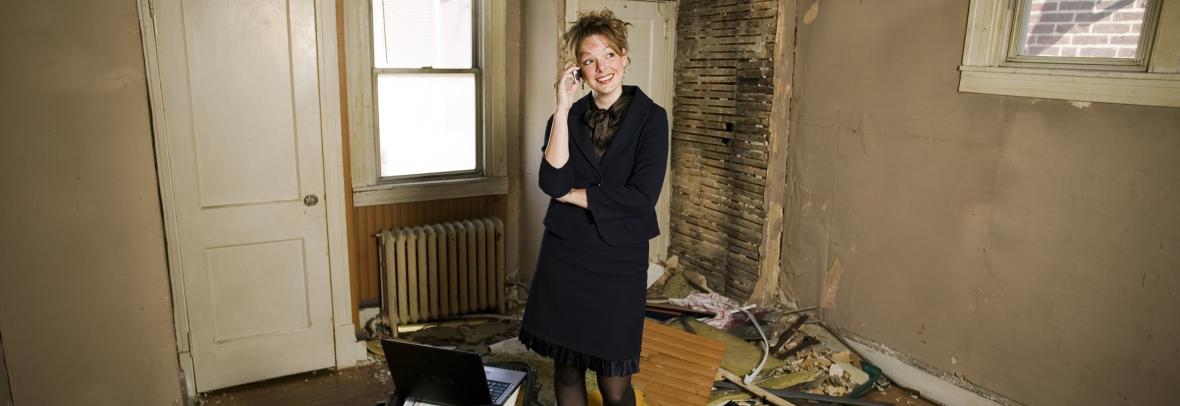NEW YORK – Milwaukee. Philadelphia. Detroit. Memphis and Baltimore. These are just a handful of the top 10 cities in the U.S. with the lowest cost of “fixer-upper” homes, according to research from StorageCafe, a nationwide storage space marketplace.
What’s a fixer-upper? It’s a house that’s available to buy at a lower price because it usually requires major work. Think of it also as a labor of love – literally. Although buyers can likely still live in a fixer-upper, they will likely need to spend a lot of time and money on maintenance and upgrades.
10 best cities for fixer-upper houses
- Milwaukee
- Philadelphia
- Detroit
- Memphis, Tennessee
- Baltimore
- Jacksonville, Florida
- Dallas
- Louisville, Kentucky
- Miami
- Fresno, California
Source: StorageCafe
“Skyrocketing home prices, bidding wars, low inventories and record-high interest rates have put many prospective homebuyers on the sidelines. But there’s still more, and that’s fixer-uppers,” said Doug Ressler, a business intelligence manager for Yardi Matrix, which provides real estate analysis for investors and conducted StorageCafe’s survey.
“(Fixer-uppers) do require a consistent amount of work – and time – until they’re ready to be called ‘home,’ but they can be a real solution for budget-minded buyers.”
StorageCafe’s study analyzed 61,200 active single-family listings as the nation’s housing market is slightly cooling and as homebuyers are backing out of purchases at the highest rate since the start of the COVID-19 pandemic, according to real-estate broker Redfin.
Brad Werner, who leads construction and real-estate practices for Wipfli, a Chicago-based accounting firm, said more homebuyers will gravitate to fixer-uppers because of a “deferred demand” due to a lack of housing that experts say range between 2-4 million homes.
“Whether there is a recession or a booming economy, everybody needs a place to live and wants housing that’s affordable,” Werner said. “With not enough new housing available, buyers are looking into the older stock.”
What is the median cost of a fixer-upper home?
The median cost of a fixer-upper home in the U.S. is around $225,000; that’s about 45% cheaper than turnkey homes in cities that are the same size, according to Porch, a home-improvement site connecting homeowners and contractors. The site also said a fixer-upper home this year is about 24% lower than last year’s estimated price of $280,000.
Buyers typically invest in a fixer-upper seeking more space, or to fix and flip the property for profit.
“This is not a simple market to get in,” said Mike Hardy, managing partner for Churchill Mortgage in Los Angeles. He is an active investor who currently has six fix-and-flips going in Southern California. “One of my mottos is simple: Is there room for a 10% profit once the house is complete and satisfied after the rehab?”
How much does it cost to renovate a home?
Home renovations and remodels average $47,803, with many projects ranging between $17,903 and $78,003, according to HomeAdvisor.com. However, keep in mind that some materials are scarce due to supply-chain issues, according to the National Association of Home Builders.
Most of the homes on StorageCafe’s list are dominated by blue-collar, working-class cities, and that’s not a coincidence, Ressler said.
Mirela Mohan, a real-estate trends expert and the author of StorageCafe’s study, told USA TODAY that cities that came out on top are generally places where fixer-upper inventory (30%) and the fixer-upper discount (30%) are high – metrics that carry the most weight in the rankings.
Milwaukee ranks No. 1 in part because fixer-uppers represent 12% of the existing homes for sale, double the overall average for the cities included in StorageCafe’s study.
For example, the study said the asking price for a fixer-upper in Milwaukee is around $80,000, nearly 60% lower than prices for regular, non-fixer-upper homes of around $195,000.
In Philadelphia, the study said about 26% of active listings fall into the “needing a little TLC” category. And for an average price of about $145,000, a fixer-upper in Philadelphia would cost buyers about half the price of a home that’s move-in ready, the study said.
Mohan said another recent StorageCafe study on real-estate activity in the past decade exemplifies why Milwaukee and Philadelphia rank first and second.
“Milwaukee is the third-worst metro area in terms of new single-family permits, with barely 15,000 permits issued over the last decade,” Mohan said. “Philadelphia fares slightly better, with nearly 70,000 new single-family units permitted over the last decade, though much lower than other urban hubs.”
And in Detroit, the study said “with its large inventory of historic homes – many of them built in the late 19th and early 20th centuries – Detroit emerges as one of the best cities to find an old gem ready to be turned into a real haven.”
The study added that 22% of the available listings in Detroit are homes in need of repairs.
It was the most affordable city in the study.
“Whether you’re snagging a charming Queen Anne or Gilded Age home in Detroit, you’d end up paying $60,000 on average for a fixer-upper – almost half of the price of a turnkey listing – a very good deal by all current pricing standards,” the study said.
And, among the 50 biggest U.S. cities, StorageCafe’s study said fixer-uppers are 32% cheaper on average than standard homes, about $307,000 versus $448,000 leading to a median savings of about $155,000.
Also, 1 in 20 houses is a fixer-upper in the top most populous cities, the study said.
“Finding a home with good bones is not the easiest task, however, and it depends a lot on the location you’re looking to buy in,” Ressler said. “Some places make it much harder than others to turn your homebuying journey into a success story like those featured on the ‘Property Brothers’ or Chip and Joanna Gaines’ ‘Fixer Upper.’”
California costliest state for renovating, flipping fixer-uppers
Meanwhile, in California, the most expensive home market in the nation, cities with the highest fixer-upper prices include San Jose at nearly $1.3 million, San Francisco at $1 million, and Los Angeles at nearly $900,000.
Other California cities, such as Long Beach at $712,000 and San Diego at $600,000, are also in the top 10 with the most expensive fixer-uppers. The list also includes Boston; Seattle; New York; Washington; and Mesa, Arizona.
Hardy, the L.A.-based investor, said he averages about a dozen flips and fixes homes across the Southern California market through his investment companies. A real-estate fixture for more than 20 years, Hardy said he currently has projects in the cities of Riverside, Covina, West Covina, as well as areas of Orange County.
He said his flips take between three and four months to complete, and can prove profitable, with a return rate of 20-25%.
Hardy recalled aggressively buying about 100 properties in need of repair with two other partners during the 2008 recession and selling them. His strategy: Move quickly, buy at the right price and fix and flip fast.
“What’s important is to be as efficient and systematic as possible,” Hardy said. “From our standpoint, we look at it as, ‘how can we have our dollars at work that’s a good business model and maximize returns?’”
Real Estate
Wenston DeSue is a realtor, organizational consultant, design, construct, build expert and developmental networker. Real estate is the business of exchange and affects every person on the planet. Real estate on all levels represents resources, access and ultimately, power. Knowledge is power…



